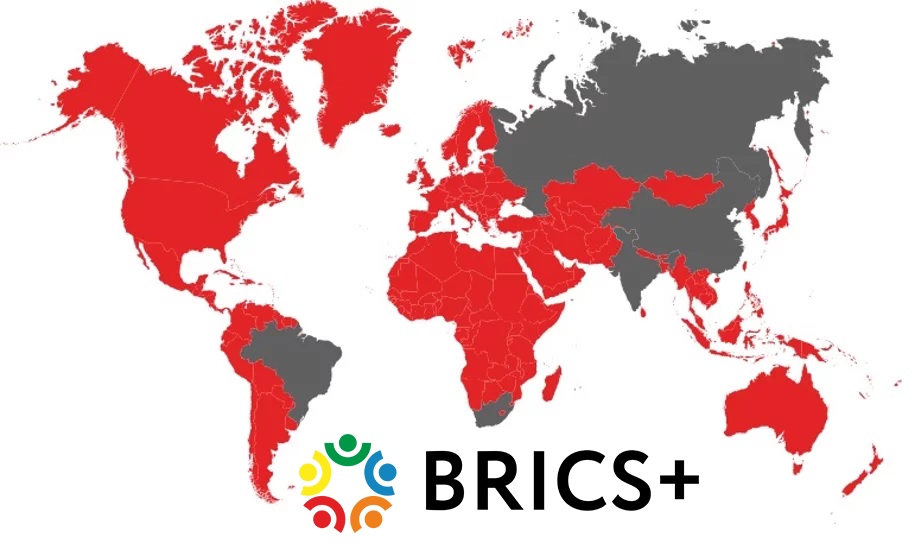
- The further expansion of the BRICS+ to include additional energy giants will solidify the group’s influence over the global energy market.
- Such expansion marks a profound turning point, propelling BRICS+ to collectively represent 45% of the world’s population, around 3.5 billion people.
- The ripple effect of this expansion has stirred discomfort in Western corridors, particularly the United States, reflecting apprehensions about the potential reconfiguration of global leadership.
At the dawn of 2024, the geopolitical landscape underwent a remarkable transformation as BRICS, a powerful alliance uniting Brazil, Russia, India, China, and South Africa, expanded its horizons, giving rise to the new era of BRICS+. This expanded alliance now includes Egypt, Ethiopia, Iran, Saudi Arabia, and the United Arab Emirates (UAE), each bringing distinctive strengths and strategic significance to the global stage.
Egypt, positioned strategically in northeast Africa and the Sinai Peninsula, emerges as a transcontinental powerhouse with influence over the vital Suez Canal and a formidable military presence. The nation’s extensive natural gas reserves further elevate its regional standing.
Ethiopia, situated in the Horn of Africa, stands out as a populous Mediterranean state, blending demographic vitality with significant economic potential. With a population surpassing 107 million, Ethiopia’s robust agricultural production, abundant water resources, and prominence in coffee and corn cultivation contribute significantly to the dynamics of BRICS+.
Iran, a formidable force in the Middle East, assumes a pivotal role in global energy policy and economics. Blessed with extensive oil and natural gas reserves, Iran’s influence extends across key regions, including the Arabian Sea and the Persian Gulf.
Saudi Arabia, a linchpin in the global oil market, plays a central role in shaping the economic landscape by contributing approximately 75% of its budget revenues and 90% of exports through oil. Meanwhile, the UAE, a federation of seven emirates, stands as a testament to economic prosperity with its rich oil and natural gas deposits, boasting an economic stature on par with developed Western nations.
This expansion marks a profound turning point, propelling BRICS+ to collectively represent 45% of the world’s population, around 3.5 billion people. Encompassing a third of the Earth’s landmass, 44% of global oil production, and nearly a third of the world’s GDP, totalling around $29 trillion, BRICS+ has surged ahead in purchasing power, equivalent to, if not surpassing, the G7.
Beyond its economic impact, over 30 additional developing nations express a keen interest in aligning with BRICS+, including nations like Algeria, Congo, Bolivia, Venezuela, Indonesia, and Kazakhstan. Despite lacking economic affluence, these countries harbour substantial mineral wealth, seeking autonomy from Western multinational corporations and reducing reliance on the dollar.
Since its inception in 2014, the New Development Bank (NDB) has emerged as a cornerstone institution for BRICS+, fostering financial cooperation. Notably, the group conducts a significant portion of its trade in national currencies, signalling a deliberate move away from the hegemony of the dollar. Ongoing discussions about a common currency and alternatives to SWIFT underscore a broader trend towards de-dollarization in the global economic ecosystem.
Looking ahead, the BRICS+ summit slated for October 2024 in Kazan, Russia, holds the promise of further expansion, potentially incorporating additional energy giants. This trajectory solidifies BRICS+’s influence over the global energy market.
The ripple effect of this expansion has stirred discomfort in Western corridors, particularly the United States, reflecting apprehensions about the potential reconfiguration of global leadership. In essence, the BRICS+ initiative marks a pivotal stride towards a new intercontinental world order, emphasizing a polycentric world that challenges the established power dynamics of yesteryears.
(Srijan Kumar is currently pursuing a PhD in South Asian studies from Delhi University. He is a writer and a columnist for various digital media houses. Opinions expressed are the author’s own)
